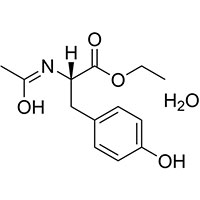N-Acetyl-L-tyrosine ethyl ester monohydrate
Nanjing Finechem Holdings Co., LTD
Synonyms
ATEE MONOHYDRATE
N-Acetyl-L-tyrosine ethyl ester hydrate
ACETYL-L-TYROSINE ETHYL ESTER HYDRATE
N-ACETYL TYROSINE ETHYL ESTER HYDRATE
Ac-Tyr-OEt.H2O
Ethyl N-acetyl-L-tyrosinate hydrate (1:1)
N-Acetyl-L-Tyr-OEt
L-Tyrosine, N-acetyl-, ethyl ester
N-ACETYLTYROSINE ETHYL ESTER 1-HYDRATE
N-Acetyl-L-tyrosine ethylester monohydrate
Product Description
Introduction:
N-Acetyl-L-tyrosine ethyl ester monohydrate, commonly known as N-Acetyltyrosine ethyl ester or NALT, is
a significant chemical compound with diverse applications in the chemical industry. This product
introduction aims to provide an overview of N-Acetyl-L-tyrosine ethyl ester monohydrate, covering its
raw materials, production process, market trends, and the current status of amino acids in the
industry.
Raw Materials:
N-Acetyl-L-tyrosine ethyl ester monohydrate is synthesized using L-tyrosine, acetic anhydride, and
ethanol as primary raw materials. L-tyrosine, a non-essential amino acid, serves as the precursor for
NALT synthesis. Acetic anhydride provides the acetyl group necessary for acetylation, while ethanol acts
as a solvent and reaction medium.
Production Process:
The production process of N-Acetyl-L-tyrosine ethyl ester monohydrate involves the following steps:
Step 1: Esterification reaction - L-tyrosine is reacted with acetic anhydride in the presence of
suitable catalysts and reaction conditions to form N-Acetyl-L-tyrosine ethyl ester. The reaction takes
place in an ethanol solvent, facilitating the esterification process.
Step 2: Monohydrate formation - The N-Acetyl-L-tyrosine ethyl ester is further processed to obtain the
monohydrate form, typically through crystallization or precipitation in the presence of water.
Step 3: Purification and refinement - The resulting N-Acetyl-L-tyrosine ethyl ester monohydrate is
purified and refined using techniques such as filtration, drying, and crystallization to achieve the
desired level of purity.
Market Trends:
The market demand for N-Acetyl-L-tyrosine ethyl ester monohydrate has been steadily increasing due to
its diverse applications across various industries. Here are some key market trends:
Nutraceuticals and Dietary Supplements: N-Acetyl-L-tyrosine ethyl ester monohydrate is widely used in
the production of nutraceuticals and dietary supplements. Its inclusion in these products is driven by
its potential to support cognitive function, mood enhancement, and stress reduction.
Sports Nutrition: The compound is utilized in sports nutrition formulations due to its role in
supporting athletic performance, focus, and mental clarity.
Pharmaceutical Industry: N-Acetyl-L-tyrosine ethyl ester monohydrate finds applications in the
pharmaceutical industry. It is used as a precursor in the synthesis of various drugs and therapeutic
compounds targeting neurological disorders, mood regulation, and cognitive health.
Current Status of Amino Acids:
Amino acids play a crucial role in various sectors, including pharmaceuticals, food additives, animal
nutrition, and agriculture. The demand for amino acids continues to grow due to their diverse
applications and essential role in biological processes. Both essential and non-essential amino acids
are widely utilized in the industry.
Conclusion:
N-Acetyl-L-tyrosine ethyl ester monohydrate, derived from L-tyrosine, holds significant value in the
chemical industry. Its production involves the combination of raw materials and precise manufacturing
processes.





